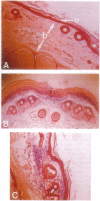Abstract
The skin and mucous membranes are the anatomical sites were most viruses are first encountered by the immune system. Previous experiments have suggested that striated muscle cells are unique among mammalian cell types in their capacity to take up and express free DNA in the absence of a viral vector or physical carrier. However, we have found that mice injected into the superficial skin with free (naked) plasmid DNA encoding the influenza nucleoprotein gene had discrete foci of epidermal and dermal cells, including cells with dendritic morphology, that contained immunoreactive nucleoprotein antigen. A single intradermal administration of 0.3-15 micrograms of free plasmid DNA induced anti-nucleoprotein-specific antibody and cytotoxic T lymphocytes that persisted for at least 68-70 weeks after vaccination. Intradermal gene administration induced higher antibody titers than did direct gene injection into skeletal muscle and did not cause local inflammation or necrosis. Compared with control animals, the gene-injected mice were resistant to challenge with a heterologous strain of influenza virus. These results indicate that the cells of the skin can take up and express free foreign DNA and induce cellular and humoral immune responses against the encoded protein. We suggest that DNA uptake by the skin-associated lymphoid tissues may play a role in the induction of cytotoxic T cells against viruses and other intracellular pathogens.
Full text
PDF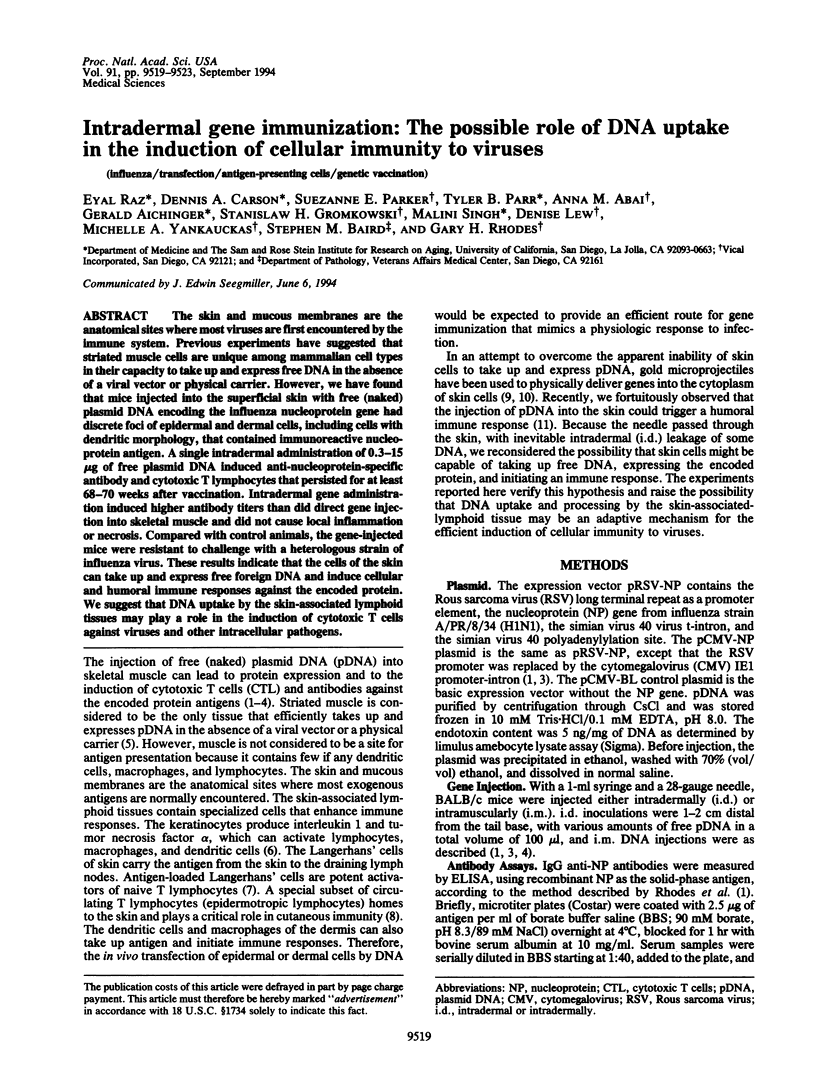
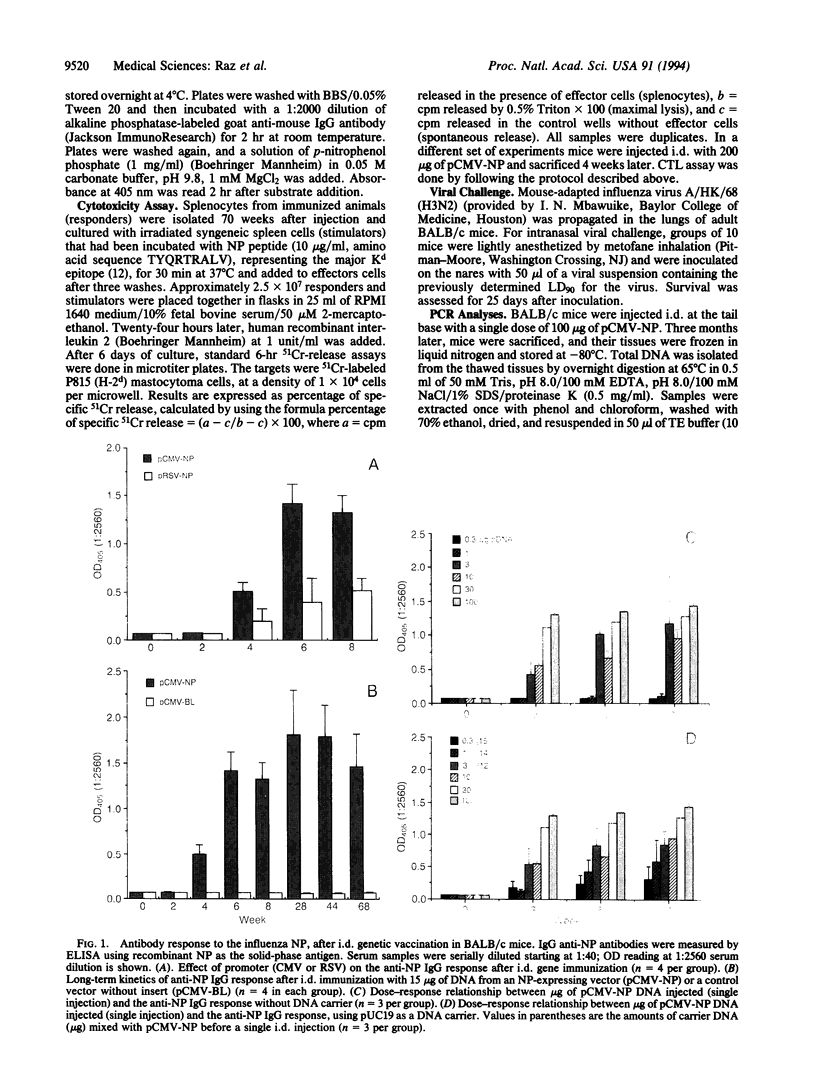
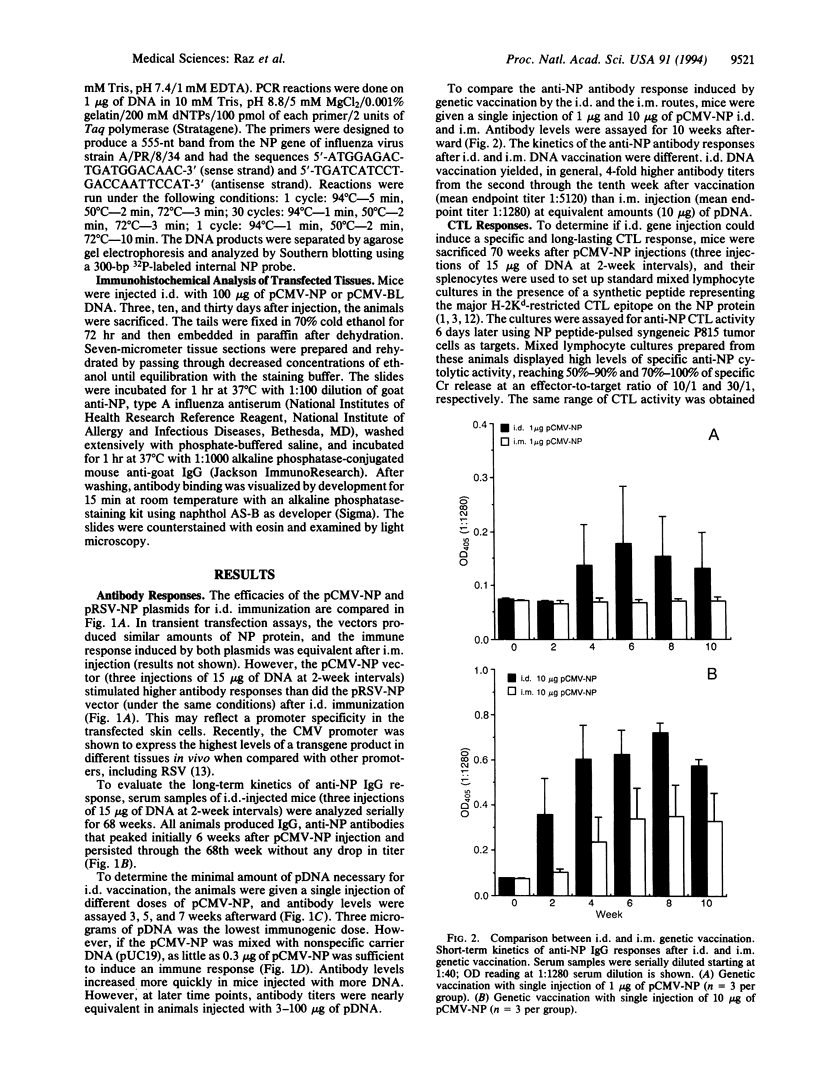
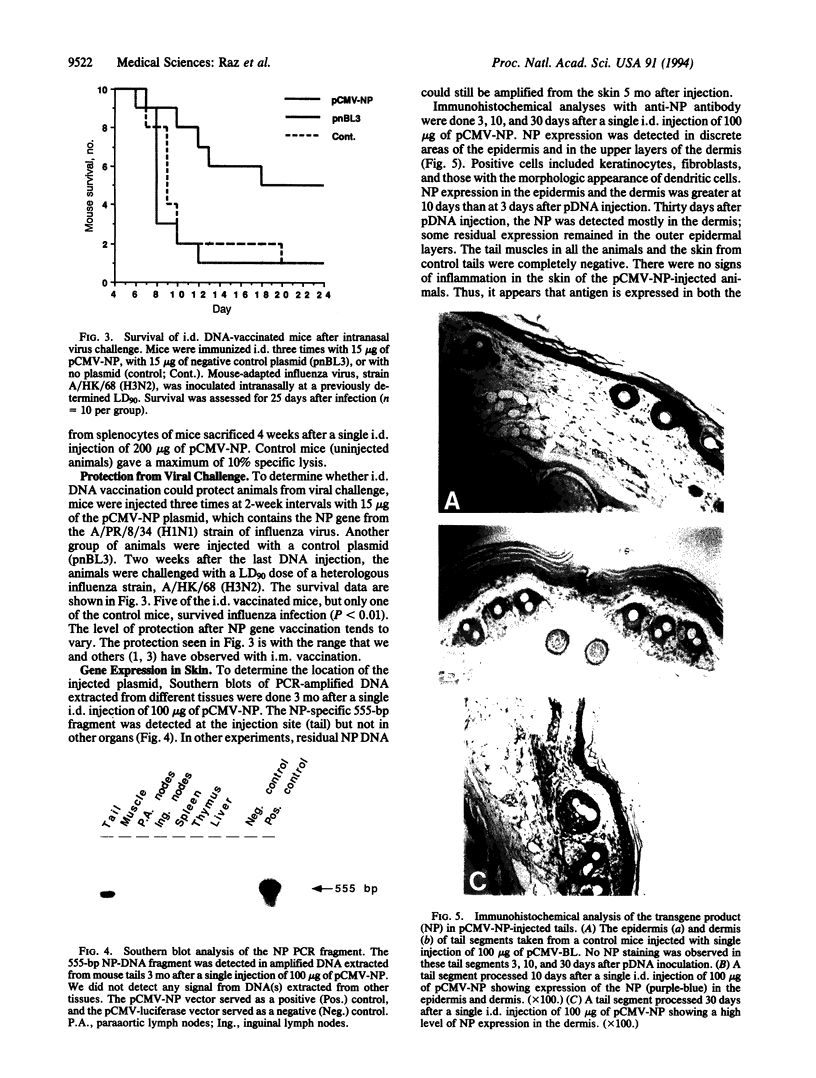
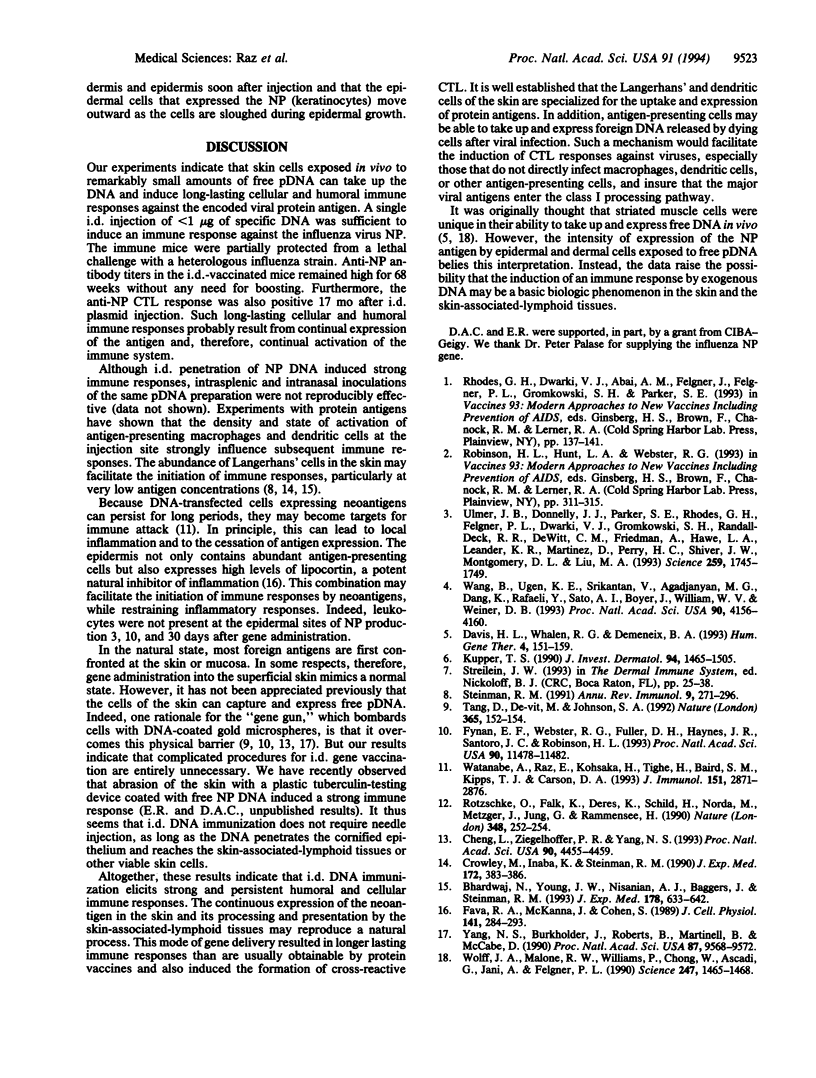
Images in this article
Selected References
These references are in PubMed. This may not be the complete list of references from this article.
- Bhardwaj N., Young J. W., Nisanian A. J., Baggers J., Steinman R. M. Small amounts of superantigen, when presented on dendritic cells, are sufficient to initiate T cell responses. J Exp Med. 1993 Aug 1;178(2):633–642. doi: 10.1084/jem.178.2.633. [DOI] [PMC free article] [PubMed] [Google Scholar]
- Cheng L., Ziegelhoffer P. R., Yang N. S. In vivo promoter activity and transgene expression in mammalian somatic tissues evaluated by using particle bombardment. Proc Natl Acad Sci U S A. 1993 May 15;90(10):4455–4459. doi: 10.1073/pnas.90.10.4455. [DOI] [PMC free article] [PubMed] [Google Scholar]
- Crowley M., Inaba K., Steinman R. M. Dendritic cells are the principal cells in mouse spleen bearing immunogenic fragments of foreign proteins. J Exp Med. 1990 Jul 1;172(1):383–386. doi: 10.1084/jem.172.1.383. [DOI] [PMC free article] [PubMed] [Google Scholar]
- Davis H. L., Whalen R. G., Demeneix B. A. Direct gene transfer into skeletal muscle in vivo: factors affecting efficiency of transfer and stability of expression. Hum Gene Ther. 1993 Apr;4(2):151–159. doi: 10.1089/hum.1993.4.2-151. [DOI] [PubMed] [Google Scholar]
- Fava R. A., McKanna J., Cohen S. Lipocortin I (p35) is abundant in a restricted number of differentiated cell types in adult organs. J Cell Physiol. 1989 Nov;141(2):284–293. doi: 10.1002/jcp.1041410209. [DOI] [PubMed] [Google Scholar]
- Fynan E. F., Webster R. G., Fuller D. H., Haynes J. R., Santoro J. C., Robinson H. L. DNA vaccines: protective immunizations by parenteral, mucosal, and gene-gun inoculations. Proc Natl Acad Sci U S A. 1993 Dec 15;90(24):11478–11482. doi: 10.1073/pnas.90.24.11478. [DOI] [PMC free article] [PubMed] [Google Scholar]
- Rötzschke O., Falk K., Deres K., Schild H., Norda M., Metzger J., Jung G., Rammensee H. G. Isolation and analysis of naturally processed viral peptides as recognized by cytotoxic T cells. Nature. 1990 Nov 15;348(6298):252–254. doi: 10.1038/348252a0. [DOI] [PubMed] [Google Scholar]
- Steinman R. M. The dendritic cell system and its role in immunogenicity. Annu Rev Immunol. 1991;9:271–296. doi: 10.1146/annurev.iy.09.040191.001415. [DOI] [PubMed] [Google Scholar]
- Tang D. C., DeVit M., Johnston S. A. Genetic immunization is a simple method for eliciting an immune response. Nature. 1992 Mar 12;356(6365):152–154. doi: 10.1038/356152a0. [DOI] [PubMed] [Google Scholar]
- Ulmer J. B., Donnelly J. J., Parker S. E., Rhodes G. H., Felgner P. L., Dwarki V. J., Gromkowski S. H., Deck R. R., DeWitt C. M., Friedman A. Heterologous protection against influenza by injection of DNA encoding a viral protein. Science. 1993 Mar 19;259(5102):1745–1749. doi: 10.1126/science.8456302. [DOI] [PubMed] [Google Scholar]
- Wang B., Ugen K. E., Srikantan V., Agadjanyan M. G., Dang K., Refaeli Y., Sato A. I., Boyer J., Williams W. V., Weiner D. B. Gene inoculation generates immune responses against human immunodeficiency virus type 1. Proc Natl Acad Sci U S A. 1993 May 1;90(9):4156–4160. doi: 10.1073/pnas.90.9.4156. [DOI] [PMC free article] [PubMed] [Google Scholar]
- Watanabe A., Raz E., Kohsaka H., Tighe H., Baird S. M., Kipps T. J., Carson D. A. Induction of antibodies to a kappa V region by gene immunization. J Immunol. 1993 Sep 1;151(5):2871–2876. [PubMed] [Google Scholar]
- Wolff J. A., Malone R. W., Williams P., Chong W., Acsadi G., Jani A., Felgner P. L. Direct gene transfer into mouse muscle in vivo. Science. 1990 Mar 23;247(4949 Pt 1):1465–1468. doi: 10.1126/science.1690918. [DOI] [PubMed] [Google Scholar]
- Yang N. S., Burkholder J., Roberts B., Martinell B., McCabe D. In vivo and in vitro gene transfer to mammalian somatic cells by particle bombardment. Proc Natl Acad Sci U S A. 1990 Dec;87(24):9568–9572. doi: 10.1073/pnas.87.24.9568. [DOI] [PMC free article] [PubMed] [Google Scholar]




